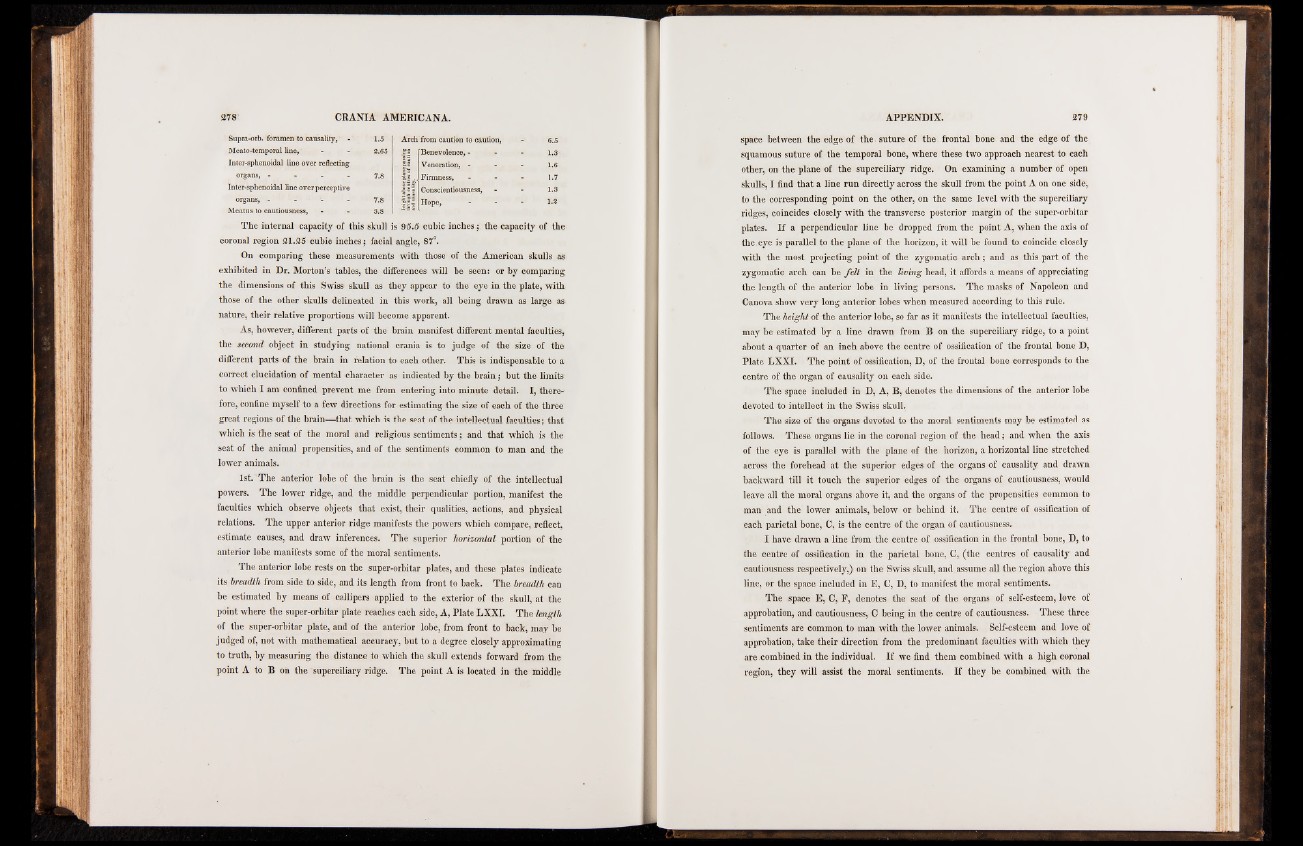
Supra-orb. foramen to causality,
1.5' Arch from caution to caution, 6.5
Meato-temporal line,
2.65 II Benevolence, - 1.3
Inter-sphenoidal line over reflecting
y Veneration, - 1.6
organs, -
7.8 I L Firmness, - 1.7
Inter-sphenoidal line over perceptive
! if Conscientiousness, 1.3
organs, - - -
7.8
| f | Hope, - 1.2
Meatus to cautiousness,
3.8
The internal capacity of this skull is 95.5 cubic inches; the capacity of the
coronal region 21.25 cubic inches; facial angle, 87°.
On comparing these measurements with those of the American skulls as
exhibited in Dr. Morton’s tables, the differences will be seen: or by comparing
the dimensions of this Swiss skull as they appear to the eye in the plate, with
those of the other skulls delineated in this work, all being drawn as large as
nature, their relative proportions will become apparent.
As, however, different parts of the brain manifest different mental faculties,
the second object in studying national crania is to judge of the size of the
different parts of the brain in relation to each other. This is indispensable to a
correct elucidation of mental character as indicated by the brain; but the limits
to which I am confined prevent me from entering into minute detail. I, therefore,
confine myself to a few directions for estimating the size of each of the three
great regions of the brain—that which is the seat of the intellectual faculties; that
which is the seat of the moral and religious sentiments; and that which is the
seat of the animal propensities, and of the sentiments common to man and the
lower animals.
1st. The anterior lobe of the brain is the seat chiefly of the intellectual
powers. The lower ridge, and the middle perpendicular portion, manifest the
faculties which observe objects that exist, their qualities, actions, and physical
relations. The upper anterior ridge manifests the powers which compare, reflect,
estimate causes, and draw inferences. The superior h o rizontal portion of the
anterior lobe manifests some of the moral sentiments.
The anterior lobe rests on the super-orbitar plates, and these plates indicate
its breadth from side to side, and its length from front to back. The breadth can
be estimated by means of callipers applied to the exterior of the skull, at the
point where the super-orbitar plate reaches each side, A, Plate LXXI. The length
of the super-orbitar plate, and of the anterior lobe, from front to back, may be
judged of, not with mathematical accuracy, but to a degree closely approximating
to truth, by measuring the distance to which the skull extends forward from the
point A to B on the superciliary ridge. The point A is located in the middle
space between the edge of the suture of the frontal bone and the edge of the
squamous suture of the temporal bone, where these two approach nearest to each
other, on the plane of the superciliary ridge. On examining a number of open
skulls, I find that a line run directly across the skull from the point A on one side,
to the corresponding point on the other, on the same level with the superciliary
ridges, coincides closely with the transverse posterior margin of the super-orbitar
plates. If a perpendicular line be dropped from the point A, when the axis of
the eye is parallel to the plane of the horizon, it will be found to coincide closely
with the most projecting point of the zygomatic arch; and as this part of the
zygomatic arch can be f e l t in the liv in g head, it affords a means of appreciating
the length of the anterior lobe in living persons. The masks of Napoleon and
Canova show very long anterior lobes when measured according to this rule.
The height of the anterior lobe, so far as it manifests the intellectual faculties,
may be estimated by a line drawn from B on the superciliary ridge, to a point
about a quarter of an inch above the centre of ossification of the frontal bone D,
Plate LXXI. The point of ossification, D, of the frontal bone corresponds to the
centre of the organ of causality on each side.
The space included in D, A, B, denotes the dimensions of the anterior lobe
devoted to intellect in the Swiss skull.
The size of the organs devoted to the moral sentiments may be estimated as
follows. These organs lie in the coronal region of the head; and when the axis
of the eye is parallel with the plane of the horizon, a horizontal line stretched
across the forehead at the superior edges of the organs of causality and drawn
backward till it touch the superior edges of the organs of cautiousness, would
leave all the moral organs above it, and the organs of the propensities common to
man and the lower animals, below or behind it. The centre of ossification of
each parietal bone, C, is the centre of the organ of cautiousness.
I have drawn a line from the centre of ossification in the frontal bone, D, to
the centre of ossification in the parietal bone, C, (the centres of causality and
cautiousness respectively,) on the Swiss skull, and assume all the region above this
line, or the space included in E, C, D, to manifest the moral sentiments.
The space E, C, F, denotes the seat of the organs of self-esteem, love of
approbation, and cautiousness, C being in the centre of cautiousness. These three
sentiments are common to man with the lower animals. Self-esteem and love of
approbation, take their direction from the predominant faculties with which they
are combined in the individual. If we find them combined with a high coronal
region, they will assist the moral sentiments. If they be combined with the